tow SATURN ION 2004 Owner's Guide
[x] Cancel search | Manufacturer: SATURN, Model Year: 2004, Model line: ION, Model: SATURN ION 2004Pages: 380, PDF Size: 2.89 MB
Page 221 of 380
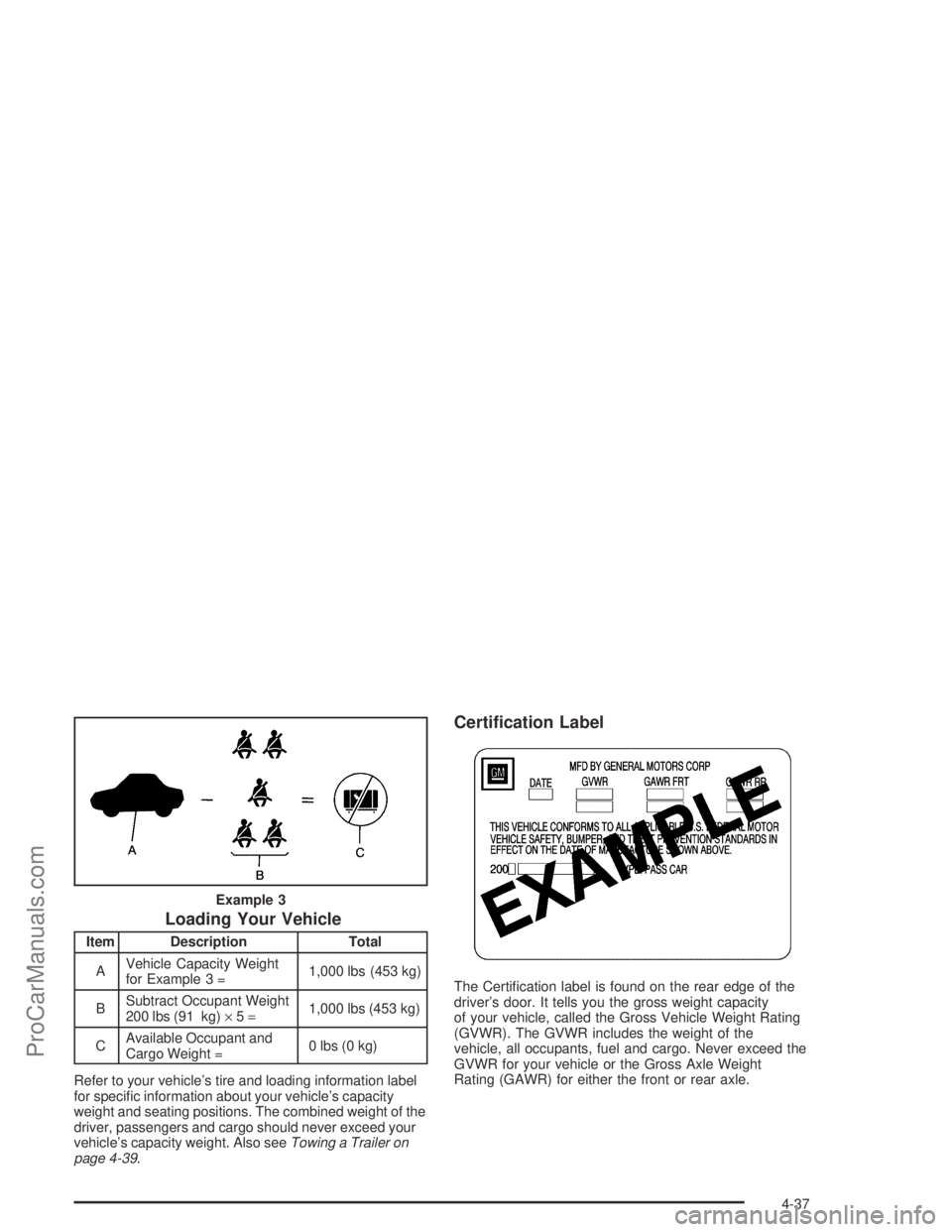
Loading Your Vehicle
Item Description Total
AVehicle Capacity Weight
for Example 3 =1,000 lbs (453 kg)
BSubtract Occupant Weight
200 lbs (91 kg)×5=1,000 lbs (453 kg)
CAvailable Occupant and
Cargo Weight =0 lbs (0 kg)
Refer to your vehicle’s tire and loading information label
for speci�c information about your vehicle’s capacity
weight and seating positions. The combined weight of the
driver, passengers and cargo should never exceed your
vehicle’s capacity weight. Also seeTowing a Trailer on
page 4-39.
Certi�cation Label
The Certi�cation label is found on the rear edge of the
driver’s door. It tells you the gross weight capacity
of your vehicle, called the Gross Vehicle Weight Rating
(GVWR). The GVWR includes the weight of the
vehicle, all occupants, fuel and cargo. Never exceed the
GVWR for your vehicle or the Gross Axle Weight
Rating (GAWR) for either the front or rear axle. Example 3
4-37
ProCarManuals.com
Page 223 of 380
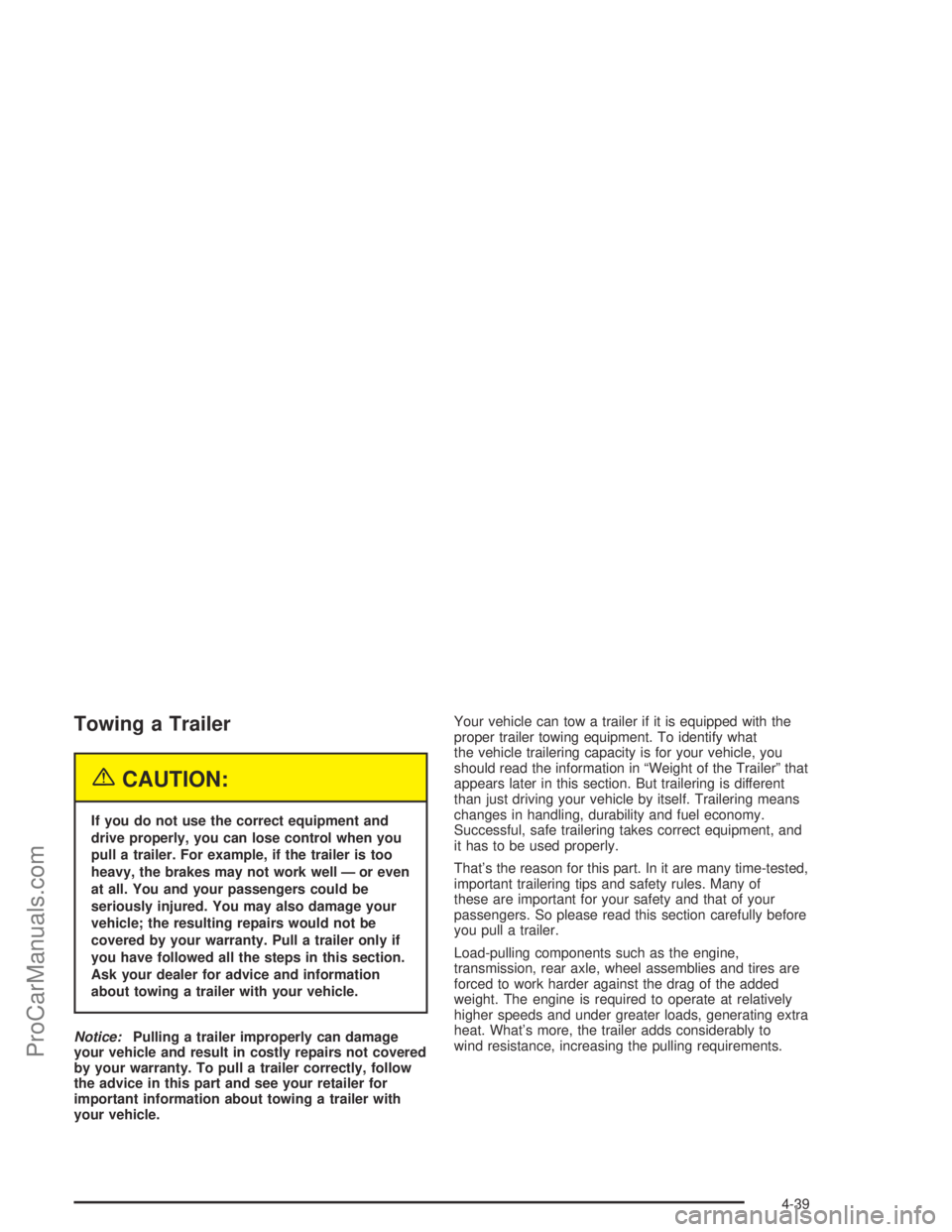
Towing a Trailer
{CAUTION:
If you do not use the correct equipment and
drive properly, you can lose control when you
pull a trailer. For example, if the trailer is too
heavy, the brakes may not work well — or even
at all. You and your passengers could be
seriously injured. You may also damage your
vehicle; the resulting repairs would not be
covered by your warranty. Pull a trailer only if
you have followed all the steps in this section.
Ask your dealer for advice and information
about towing a trailer with your vehicle.
Notice:Pulling a trailer improperly can damage
your vehicle and result in costly repairs not covered
by your warranty. To pull a trailer correctly, follow
the advice in this part and see your retailer for
important information about towing a trailer with
your vehicle.Your vehicle can tow a trailer if it is equipped with the
proper trailer towing equipment. To identify what
the vehicle trailering capacity is for your vehicle, you
should read the information in “Weight of the Trailer” that
appears later in this section. But trailering is different
than just driving your vehicle by itself. Trailering means
changes in handling, durability and fuel economy.
Successful, safe trailering takes correct equipment, and
it has to be used properly.
That’s the reason for this part. In it are many time-tested,
important trailering tips and safety rules. Many of
these are important for your safety and that of your
passengers. So please read this section carefully before
you pull a trailer.
Load-pulling components such as the engine,
transmission, rear axle, wheel assemblies and tires are
forced to work harder against the drag of the added
weight. The engine is required to operate at relatively
higher speeds and under greater loads, generating extra
heat. What’s more, the trailer adds considerably to
wind resistance, increasing the pulling requirements.
4-39
ProCarManuals.com
Page 224 of 380

If You Do Decide to Pull a Trailer
If you do, here are some important points:
There are many different laws, including speed limit
restrictions, having to do with trailering. Make sure
your rig will be legal, not only where you live
but also where you’ll be driving. A good source for
this information can be state or provincial police.
Consider using a sway control. You can ask a hitch
dealer about sway controls.
Don’t tow a trailer at all during the �rst 1000 miles
(1600 km) your new vehicle is driven. Your engine,
axle or other parts could be damaged. The
repairs would not be covered by your warranty.
Then, during the �rst 500 miles (805 km) that you
tow a trailer, don’t drive over 50 mph (80 km/h)
and don’t make starts at full throttle. This helps your
engine and other parts of your vehicle wear in at
the heavier loads.
Obey speed limit restrictions when towing a trailer.
Don’t drive faster than the maximum posted speed
for trailers, or no more than 55 mph (90 km/h),
to save wear on your vehicle’s parts.
Don’t tow a trailer when the outside temperature is
above 100°F (38°C).
Three important considerations have to do with weight:
the weight of the trailer,
the weight of the trailer tongue
and the total weight on your vehicle’s tires.
4-40
ProCarManuals.com
Page 225 of 380
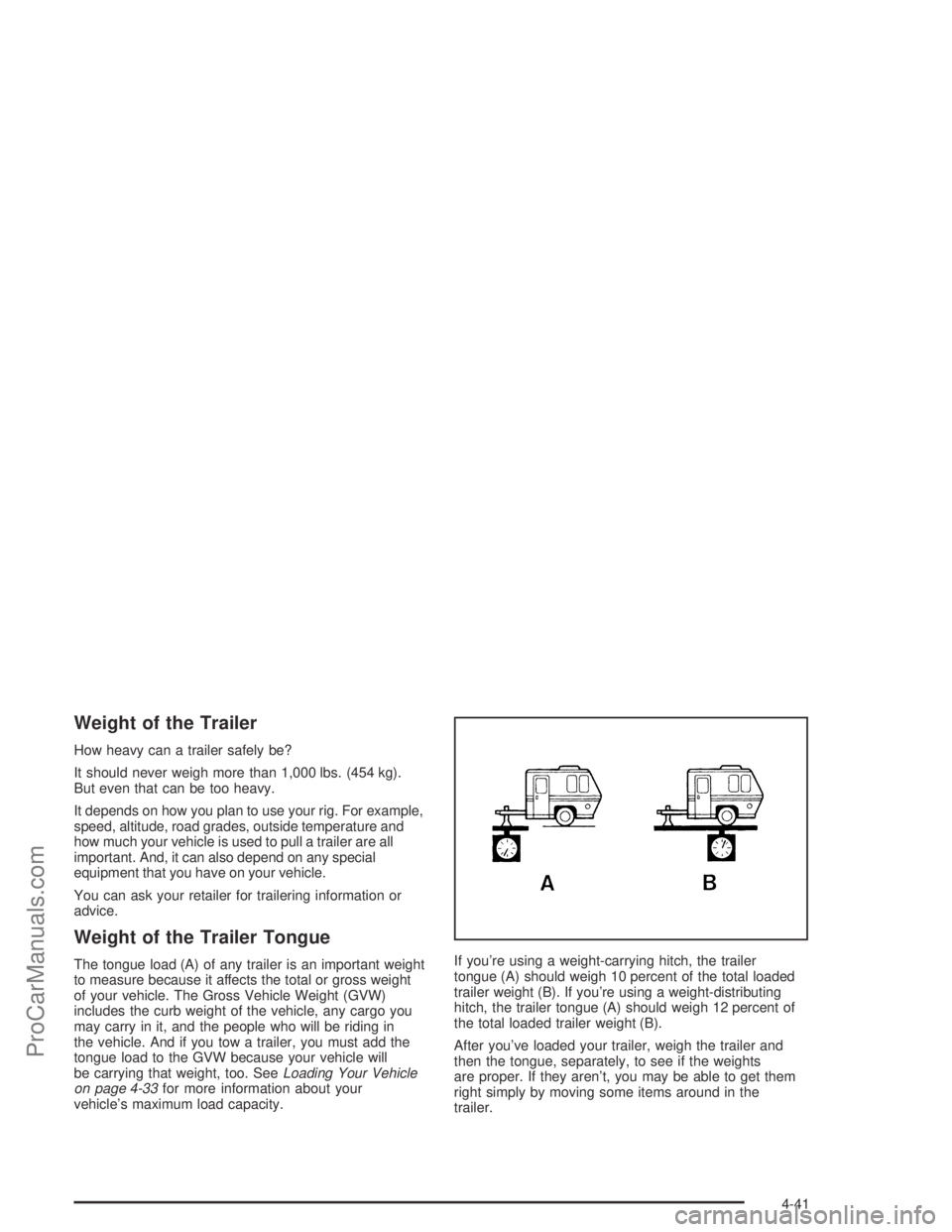
Weight of the Trailer
How heavy can a trailer safely be?
It should never weigh more than 1,000 lbs. (454 kg).
But even that can be too heavy.
It depends on how you plan to use your rig. For example,
speed, altitude, road grades, outside temperature and
how much your vehicle is used to pull a trailer are all
important. And, it can also depend on any special
equipment that you have on your vehicle.
You can ask your retailer for trailering information or
advice.
Weight of the Trailer Tongue
The tongue load (A) of any trailer is an important weight
to measure because it affects the total or gross weight
of your vehicle. The Gross Vehicle Weight (GVW)
includes the curb weight of the vehicle, any cargo you
may carry in it, and the people who will be riding in
the vehicle. And if you tow a trailer, you must add the
tongue load to the GVW because your vehicle will
be carrying that weight, too. SeeLoading Your Vehicle
on page 4-33for more information about your
vehicle’s maximum load capacity.If you’re using a weight-carrying hitch, the trailer
tongue (A) should weigh 10 percent of the total loaded
trailer weight (B). If you’re using a weight-distributing
hitch, the trailer tongue (A) should weigh 12 percent of
the total loaded trailer weight (B).
After you’ve loaded your trailer, weigh the trailer and
then the tongue, separately, to see if the weights
are proper. If they aren’t, you may be able to get them
right simply by moving some items around in the
trailer.
4-41
ProCarManuals.com
Page 227 of 380

Driving with a Trailer
Towing a trailer requires a certain amount of experience.
Before setting out for the open road, you’ll want to get
to know your rig. Acquaint yourself with the feel of
handling and braking with the added weight of the trailer.
And always keep in mind that the vehicle you are
driving is now a good deal longer and not nearly as
responsive as your vehicle is by itself.
Before you start, check the trailer hitch and platform
(and attachments), safety chains, electrical connector,
lamps, tires and mirror adjustment. If the trailer has
electric brakes, start your vehicle and trailer moving and
then apply the trailer brake controller by hand to be
sure the brakes are working. This lets you check your
electrical connection at the same time.
During your trip, check occasionally to be sure that the
load is secure, and that the lamps and any trailer
brakes are still working.
Following Distance
Stay at least twice as far behind the vehicle ahead as
you would when driving your vehicle without a trailer.
This can help you avoid situations that require
heavy braking and sudden turns.
Passing
You’ll need more passing distance up ahead when
you’re towing a trailer. And, because you’re a good deal
longer when towing a trailer, you’ll need to go much
farther beyond the passed vehicle before you can return
to your lane.
Backing Up
Hold the bottom of the steering wheel with one hand.
Then, to move the trailer to the left, just move that hand
to the left. To move the trailer to the right, move your
hand to the right. Always back up slowly and, if possible,
have someone guide you.
Making Turns
Notice:Making very sharp turns while trailering
could cause the trailer to come in contact with the
vehicle. Your vehicle could be damaged. Avoid
making very sharp turns while trailering.
When you’re turning with a trailer, make wider turns
than normal. Do this so your trailer won’t strike
soft shoulders, curbs, road signs, trees or other objects.
Avoid jerky or sudden maneuvers. Signal well in
advance.
4-43
ProCarManuals.com
Page 228 of 380
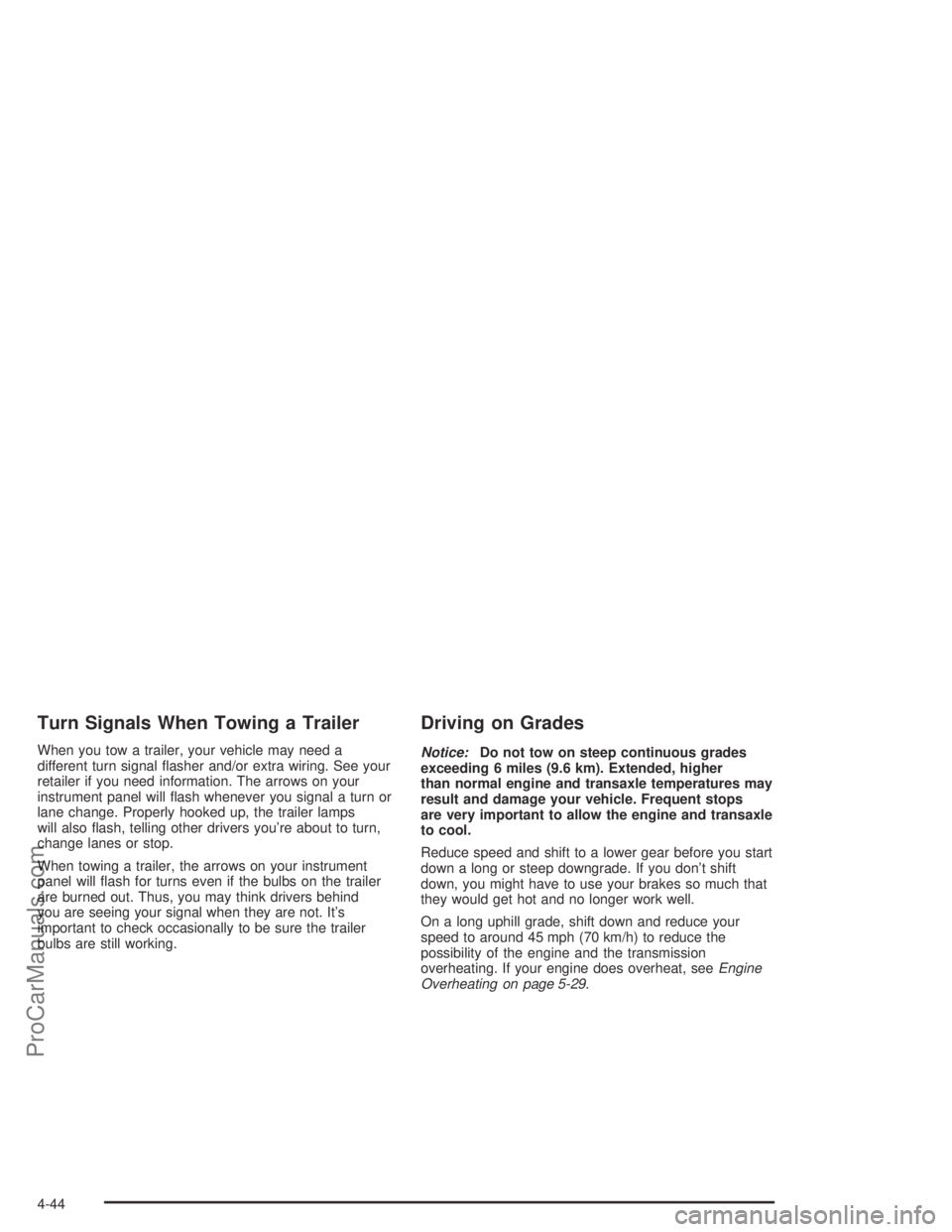
Turn Signals When Towing a Trailer
When you tow a trailer, your vehicle may need a
different turn signal �asher and/or extra wiring. See your
retailer if you need information. The arrows on your
instrument panel will �ash whenever you signal a turn or
lane change. Properly hooked up, the trailer lamps
will also �ash, telling other drivers you’re about to turn,
change lanes or stop.
When towing a trailer, the arrows on your instrument
panel will �ash for turns even if the bulbs on the trailer
are burned out. Thus, you may think drivers behind
you are seeing your signal when they are not. It’s
important to check occasionally to be sure the trailer
bulbs are still working.
Driving on Grades
Notice:Do not tow on steep continuous grades
exceeding 6 miles (9.6 km). Extended, higher
than normal engine and transaxle temperatures may
result and damage your vehicle. Frequent stops
are very important to allow the engine and transaxle
to cool.
Reduce speed and shift to a lower gear before you start
down a long or steep downgrade. If you don’t shift
down, you might have to use your brakes so much that
they would get hot and no longer work well.
On a long uphill grade, shift down and reduce your
speed to around 45 mph (70 km/h) to reduce the
possibility of the engine and the transmission
overheating. If your engine does overheat, seeEngine
Overheating on page 5-29.
4-44
ProCarManuals.com
Page 230 of 380
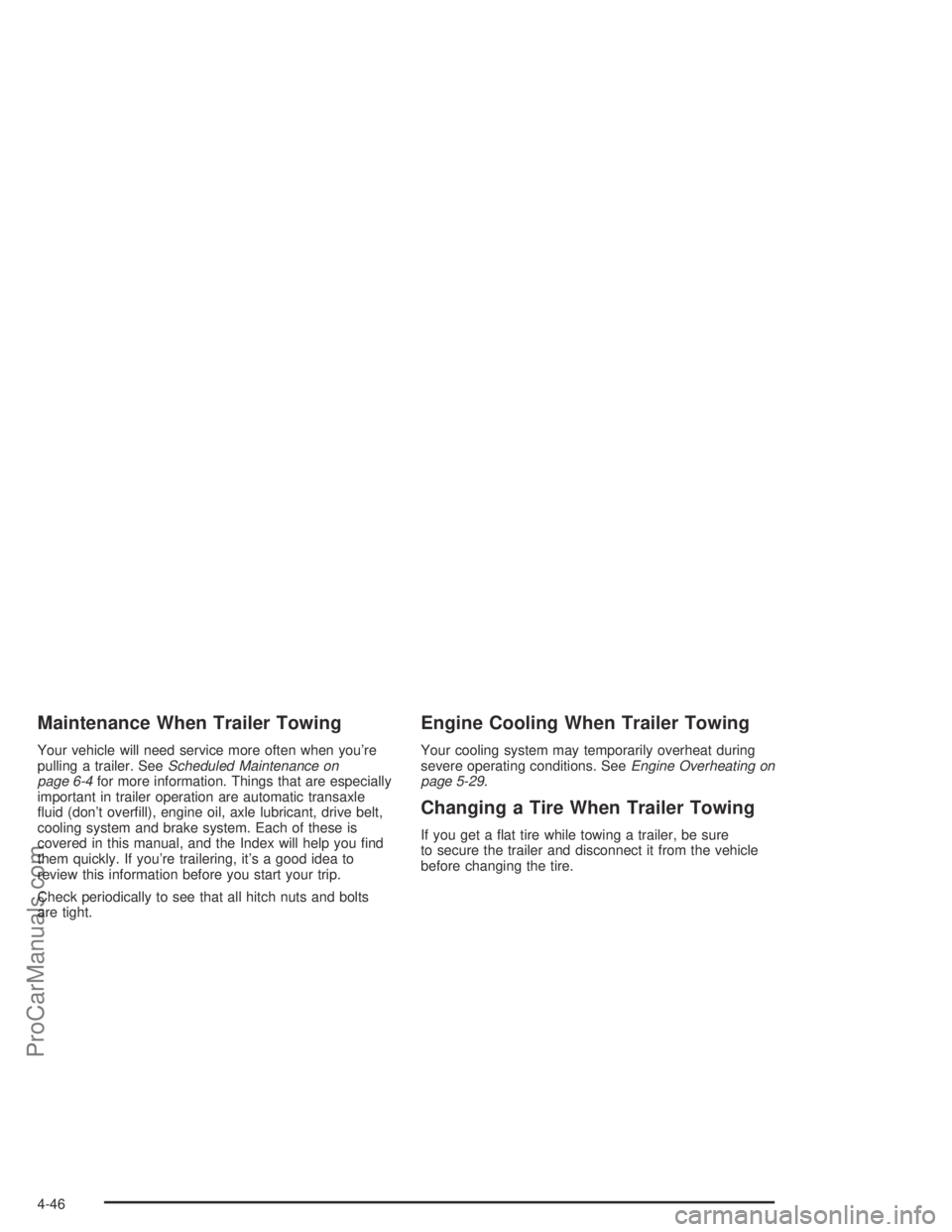
Maintenance When Trailer Towing
Your vehicle will need service more often when you’re
pulling a trailer. SeeScheduled Maintenance on
page 6-4for more information. Things that are especially
important in trailer operation are automatic transaxle
�uid (don’t over�ll), engine oil, axle lubricant, drive belt,
cooling system and brake system. Each of these is
covered in this manual, and the Index will help you �nd
them quickly. If you’re trailering, it’s a good idea to
review this information before you start your trip.
Check periodically to see that all hitch nuts and bolts
are tight.
Engine Cooling When Trailer Towing
Your cooling system may temporarily overheat during
severe operating conditions. SeeEngine Overheating on
page 5-29.
Changing a Tire When Trailer Towing
If you get a �at tire while towing a trailer, be sure
to secure the trailer and disconnect it from the vehicle
before changing the tire.
4-46
ProCarManuals.com
Page 245 of 380
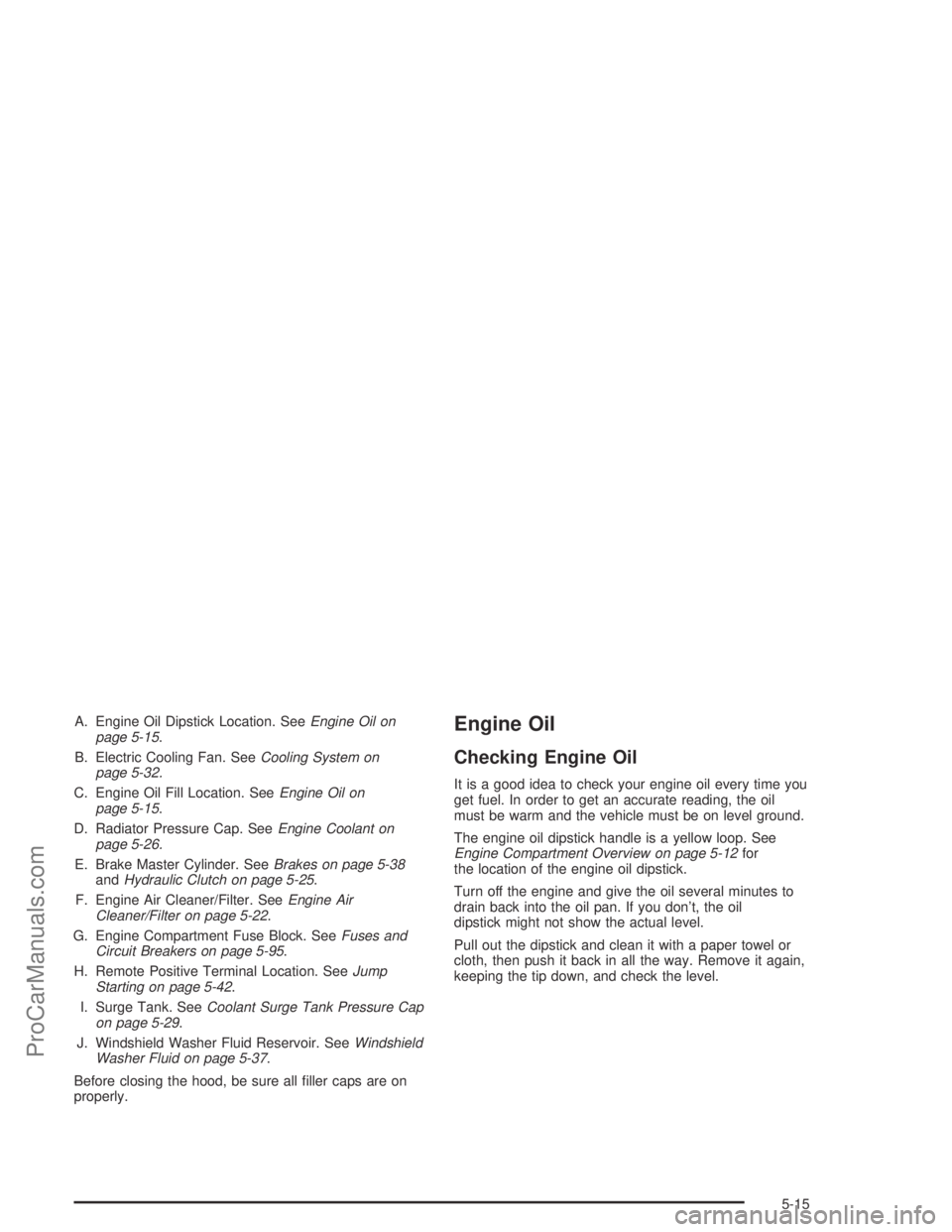
A. Engine Oil Dipstick Location. SeeEngine Oil on
page 5-15.
B. Electric Cooling Fan. SeeCooling System on
page 5-32.
C. Engine Oil Fill Location. SeeEngine Oil on
page 5-15.
D. Radiator Pressure Cap. SeeEngine Coolant on
page 5-26.
E. Brake Master Cylinder. SeeBrakes on page 5-38
andHydraulic Clutch on page 5-25.
F. Engine Air Cleaner/Filter. SeeEngine Air
Cleaner/Filter on page 5-22.
G. Engine Compartment Fuse Block. SeeFuses and
Circuit Breakers on page 5-95.
H. Remote Positive Terminal Location. SeeJump
Starting on page 5-42.
I. Surge Tank. SeeCoolant Surge Tank Pressure Cap
on page 5-29.
J. Windshield Washer Fluid Reservoir. SeeWindshield
Washer Fluid on page 5-37.
Before closing the hood, be sure all �ller caps are on
properly.Engine Oil
Checking Engine Oil
It is a good idea to check your engine oil every time you
get fuel. In order to get an accurate reading, the oil
must be warm and the vehicle must be on level ground.
The engine oil dipstick handle is a yellow loop. See
Engine Compartment Overview on page 5-12for
the location of the engine oil dipstick.
Turn off the engine and give the oil several minutes to
drain back into the oil pan. If you don’t, the oil
dipstick might not show the actual level.
Pull out the dipstick and clean it with a paper towel or
cloth, then push it back in all the way. Remove it again,
keeping the tip down, and check the level.
5-15
ProCarManuals.com
Page 254 of 380
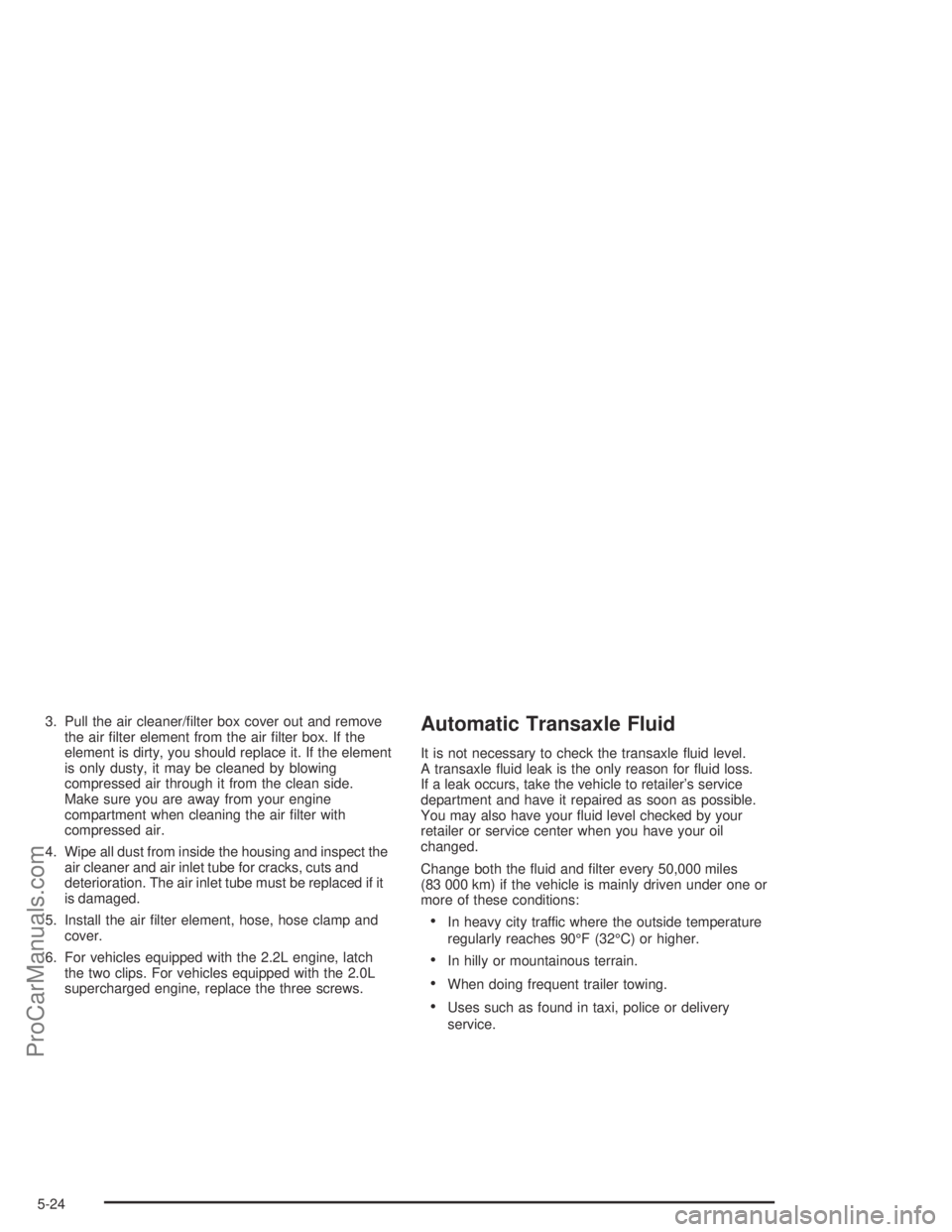
3. Pull the air cleaner/�lter box cover out and remove
the air �lter element from the air �lter box. If the
element is dirty, you should replace it. If the element
is only dusty, it may be cleaned by blowing
compressed air through it from the clean side.
Make sure you are away from your engine
compartment when cleaning the air �lter with
compressed air.
4. Wipe all dust from inside the housing and inspect the
air cleaner and air inlet tube for cracks, cuts and
deterioration. The air inlet tube must be replaced if it
is damaged.
5. Install the air �lter element, hose, hose clamp and
cover.
6. For vehicles equipped with the 2.2L engine, latch
the two clips. For vehicles equipped with the 2.0L
supercharged engine, replace the three screws.Automatic Transaxle Fluid
It is not necessary to check the transaxle �uid level.
A transaxle �uid leak is the only reason for �uid loss.
If a leak occurs, take the vehicle to retailer’s service
department and have it repaired as soon as possible.
You may also have your �uid level checked by your
retailer or service center when you have your oil
changed.
Change both the �uid and �lter every 50,000 miles
(83 000 km) if the vehicle is mainly driven under one or
more of these conditions:
In heavy city traffic where the outside temperature
regularly reaches 90°F (32°C) or higher.
In hilly or mountainous terrain.
When doing frequent trailer towing.
Uses such as found in taxi, police or delivery
service.
5-24
ProCarManuals.com
Page 261 of 380

If No Steam Is Coming From Your
Engine
An overheat warning can indicate a serious problem.
SeeLow Coolant Level Warning Message on page 3-43.
If you get an engine overheat warning with no warning
messages, but see or hear no steam, the problem
may not be too serious. Sometimes the engine can get
a little too hot when you:
Climb a long hill on a hot day.
Stop after high-speed driving.
Idle for long periods in traffic.
Tow a trailer.
If you get the overheat warning with no sign of steam,
try this for a minute or so:
1. If you have an air conditioner and it’s on, turn it off.
2. Turn on your heater to full hot at the highest fan
speed and open the window as necessary.
3. Try to minimize engine load. If you’re in a traffic
jam, shift to NEUTRAL (N); otherwise, shift to the
highest gear while driving.If you no longer have the overheat warning, you can
drive. Just to be safe, drive slower for about 10 minutes.
If the warning doesn’t come back on, you can drive
normally.
If the warning continues and you have not stopped,
pull over, stop, and park your vehicle right away.
If there’s still no sign of steam, you can idle the engine
for three minutes while you’re parked. If you still
have the warning,turn off the engine and get everyone
out of the vehicleuntil it cools down.
You may decide not to lift the hood but to get service
help right away.
5-31
ProCarManuals.com